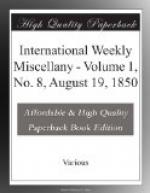The bones are selected with care, and sold to the soap-boiler. He boils out the fat and marrow first, for special use, and the bones are then crushed and sold for manure.
Of rags, the woollen rags are bagged and sent off for hop-manure; the white linen rags are washed, and sold to make paper, &c.
The “tin things” are collected and put into an oven with a grating at the bottom, so that the solder which unites the parts melts, and runs through into a receiver. This is sold separately; the detached pieces of tin are then sold to be melted up with old iron, &c.
Bits of old brass, lead, &c., are sold to be molted up separately, or in the mixture of ores.
All broken glass vessels, as cruets, mustard-pots, tumblers, wine-glasses, bottles, &c., are sold to the old-glass shops.
As for any articles of jewelry, silver spoons, forks, thimbles, or other plate and valuables, they are pocketed off-hand by the first finder. Coins of gold and silver are often found, and many “coppers.”
Meantime, everybody is hard at work near the base of the great Dust-heap. A certain number of cart-loads having been raked and searched for all the different things just described, the whole of it now undergoes the process of sifting. The men throw up the stuff, and the women sift it.
“When I was a young girl,” said Peg Dotting—
“That’s a long while ago, Peggy,” interrupted one of the sifters: but Peg did not hear her.
“When I was quite a young thing,” continued she, addressing old John Doubleyear, who threw up the dust into her sieve, “it was the fashion to wear pink roses in the shoes, as bright as that morsel of ribbon Sally has just picked out of the dust; yes, and sometimes in the hair, too, on one side of the head, to set off the white powder and salve-stuff. I never wore one of these head-dresses myself—don’t throw up the dust so high, John—but I lived only a few doors lower down from those as did. Don’t throw up the dust so high, I tell ’ee—the wind takes it into my face.”
“Ah! There! What’s that?” suddenly exclaimed little Jem, running as fast as his poor withered legs would allow him toward a fresh heap, which had just been shot down on the wharf from a dustman’s cart. He made a dive and a search—then another—then one deeper still. “I’m sure I saw it!” cried he, and again made a dash with both hands into a fresh place, and began to distribute the ashes and dust and rubbish on every side, to the great merriment of all the rest.
“What did you see, Jemmy?” asked old Doubleyear, in a compassionate tone.
“Oh, I don’t know,” said the boy, “only it was like a bit of something made of real gold!”
A fresh burst of laughter from the company assembled followed this somewhat vague declaration, to which the dustmen added one or two elegant epithets, expressive of their contempt of the notion that they could have overlooked a bit of anything valuable in the process of emptying sundry dust-holes, and carting them away.




